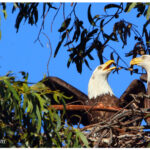Thanks to Hollywood, you have probably heard the call of the red-tailed hawk, described as a rasping descending scream, a drawn-out screech, a high-pitched scream, or a slurring call. Often, the bird on the screen is not a red-tail but another species in the air. Sound directors dub in the iconic call of the red-tail to add a sense of awe, recognition, and an element of wildness so the audience is drawn into the scene, immediately feels at home, and is transported to wherever the particular plot will take them.

The call of the red-tailed hawk is known throughout most of North America. Modern day travelers are also familiar with seeing a red-tail sitting atop a power pole or some other high perch as they pass beneath it along roadways both urban and wild.

Buteo jamaicensis, their scientific name, were first identified in Jamaica in 1781 and described by Sibley Guides as common and widespread. They’re one of our largest buteos, weighing in at 2.4 pounds with a 49-inch wingspan. Only the ferruginous hawk is larger. Buteos are a group of birds of prey with broad wings used for soaring.
Speaking of soaring, look for the dark patagial marks on the leading edge of the underwing as it flies overhead. Since red-tails can be highly variable in color and feathering with 14 recognized subspecies, the patagial marks can help identify an otherwise confusing bird. But if you come across a dark phase individual you may not be able to see these marks. And the tail may not be red, as is the case with juveniles.

Also, young birds have a yellowish iris that turns darker as they age. Another helpful indicator on the back of red-tails is a white-speckled V. Do not despair, with practice and continued field observations, the red-tailed hawk becomes increasingly identifiable.

Range maps indicate that red-tails are mostly year round residents in our area. Both parents share nest-building duties, raising the young, and are generally monogamous. Nests are usually in trees up to 120 feet high but they will use cliffsides and human-made structures. Clutch size is 2 to 3 eggs and incubation is 28 to 35 days. The young are ready to leave the nest and fledge in 44 to 48 days.

Their diet consists of mammals, rodents, snakes, lizards, and birds. Ground squirrels are among the red-tails favorite prey. They hunt by sight and fly from perch, soaring and occasionally kiting or hovering. Often, they will stay on the ground to eat their prey and you can see them protecting their catch by “mantling”—spreading their wings to cover and hide the prey from would-be thieves. I once watched a red-tail perched high in a tree suddenly fly down and literally run along the ground chasing its prey, which turned out to be a lizard. The bird played cat-and-mouse with the lizard before dispatching it.

The red-tailed hawk, for many, is the first hawk to be identified and remains one of the most photographed hawks, especially with the advent of modern cameras. I remember being flummoxed when trying to identify many species, even these large buteos—except when their red tails were obviously displayed. Then, a sense of accomplishment and relief would wash over me, for here was a bird that I knew! They can be seen in many different types of habitat. In Alameda, there are many places to view red-tails—Crab Cove, Alameda Point, Corica Park, along the coast wherever there is appropriate nearby tree cover, and in almost any park. The fact that there are so many is testament to a healthy food supply and appropriate hawk-friendly habitat. Go out and see how many varieties of red-tailed hawks you can find. It is a wonderful pastime and will certainly sharpen your birding skills.
Rick Lewis is a long time member of Golden Gate Bird Alliance and other environmental organizations. He contributes often to Bay Area and Central Valley birding groups that promote wildlife and habitat conservation. This is part of a series of articles coordinated by the Friends of the Alameda Wildlife Reserve (FAWR), a Conservation Committee of Golden Gate Bird Alliance (formerly Audubon). To join a free guided bird walk, visit Golden Gate Audubon’s Field Trip web page.





